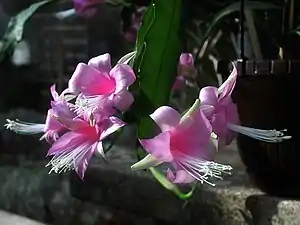Disocactus nelsonii
Disocactus nelsonii ist eine Pflanzenart aus der Gattung Disocactus in der Familie der Kakteengewächse (Cactaceae). Das Artepitheton nelsonii ehrt den US-amerikanischen Naturforscher Edward William Nelson.[1]
| Disocactus nelsonii | ||||||||||||
|---|---|---|---|---|---|---|---|---|---|---|---|---|

Disocactus nelsonii | ||||||||||||
| Systematik | ||||||||||||
| ||||||||||||
| Wissenschaftlicher Name | ||||||||||||
| Disocactus nelsonii | ||||||||||||
| (Britton & Rose) Linding. |
Beschreibung
Disocactus nelsonii wächst reich verzweigt, aufsteigend, dann hängend, basal drehrund darüber abgeflacht. Die Haupttriebe werden bis zu 1,6 Meter lang. Die Seitentriebe erscheinen aus der oberen Hälfte der Haupttriebe. Sie sind mit Ausnahme von der drehrunden Basis abgeflacht, lanzettlich, dunkelgrün und werden bis zu 6 Zentimeter lang und 3 bis 4 Zentimeter breit. Die Areolen sind zuweilen mit einigen wenigen borstenartigen Dornen versehen.
Die Blüten erscheinen einzeln nahe der Triebspitzen. Sie sind aufwärts gebogen, purpurrosa oder rot mit violettem Hauch, röhrich-trichterig und werden 7 bis 8 Zentimeter lang.
Verbreitung, Systematik und Gefährdung
Disocactus nelsonii ist in dem mexikanischen Bundesstaat Chiapas, in Guatemala in dem Verwaltungsbezirk Chimaltenango in Höhenlagen zwischen 1000 und 2300 Metern und in Honduras im Verwaltungsbezirk Comayagua in Höhenlagen zwischen 1400 und 1500 Metern verbreitet.
Die Erstbeschreibung als Epiphyllum nelsonii erfolgte 1913 durch Nathaniel Lord Britton und Joseph Nelson Rose.[2] Karl Hermann Leonhard Lindinger (1879–1965) stellte die Art 1942 in die Gattung Disocactus.[3] Weitere nomenklatorische Synonyme sind Phyllocactus nelsonii (Britton & Rose) Vaupel (1913) und Chiapasia nelsonii (Britton & Rose) Britton & Rose (1923).
Es werden folgende Unterarten unterschieden:[4]
- Disocactus nelsonii subsp. nelsonii
- Disocactus nelsonii subsp. hondurensis (Kimnach) Doweld
In der Roten Liste gefährdeter Arten der IUCN wird die Art als „Least Concern (LC)“, d. h. als nicht gefährdet geführt.[5]
Nachweise
Literatur
- Edward F. Anderson: Das große Kakteen-Lexikon. 2. Auflage. Eugen Ulmer KG, Stuttgart 2011, ISBN 978-3-8001-5964-2, S. 185–186.
- N. L. Britton, J. N. Rose: The Cactaceae. Descriptions and Illustrations of Plants of the Cactus Family. Band IV. The Carnegie Institution of Washington, Washington 1923, S. 203 (online).
Einzelnachweise
- Urs Eggli, Leonard E. Newton: Etymological Dictionary of Succulent Plant Names. Birkhäuser 2004, ISBN 3-540-00489-0, S. 164.
- N. L. Britton, J. N. Rose: The genus Epiphyllum and its allies. In: Contributions from the United States National Herbarium. Band 16, 1913, S. 257 (online).
- Beihefte zum Botanischen Centralblatt. Abt. 1, Anatomie, Histologie, Morphologie und Physiologie der Pflanzen. Band 61, Nummer 3, Kassel 1942, S. 383.
- Nadja Korotkova, David Aquino, Salvador Arias, Urs Eggli, Alan Franck, Carlos Gómez-Hinostrosa, Pablo C. Guerrero, Héctor M. Hernández, Andreas Kohlbecker, Matias Köhler, Katja Luther, Lucas C. Majure, Andreas Müller, Detlev Metzing, Reto Nyffeler, Daniel Sánchez, Boris Schlumpberger, Walter G. Berendsohn: Cactaceae at Caryophyllales.org – a dynamic online species-level taxonomic backbone for the family – Electronic supplement. In: Willdenowia. Band 51, Nr. 2, 2021, S. 84 (doi:10.3372/wi.51.51208).
- Disocactus nelsonii in der Roten Liste gefährdeter Arten der IUCN 2013.2. Eingestellt von: Véliz, M., Arias, S. & Ishiki, M., 2009. Abgerufen am 5. Januar 2014.